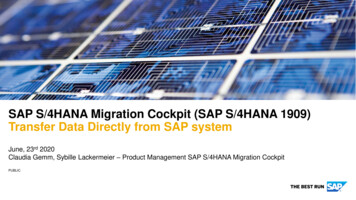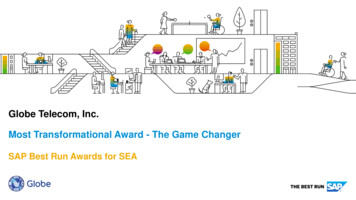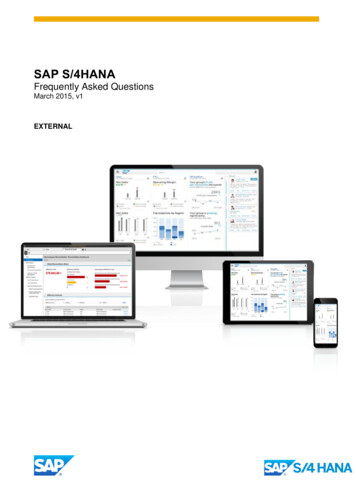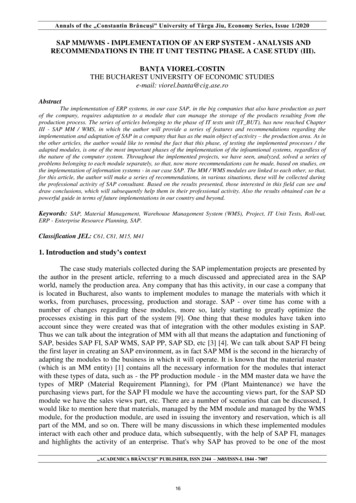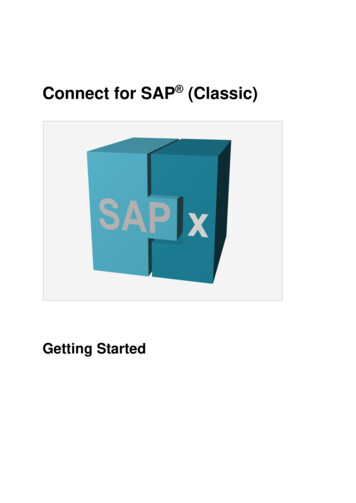
Transcription
Connect for SAP (Classic)Getting Started
1About this Document .32About Connect for SAP (Classic) .43Architectural overview .53.1RFC Function Architecture .63.1.1Data Representation .63.1.2Data Mapping .73.1.3Early and Late Function Binding . 103.2Client Applications . 123.2.13.2.23.33.3.13.3.24Installation . 164.1System Requirements . 164.2Installing the RFC Library Binaries. 164.2.1SAPGUI installation. 164.2.24.2.34.34.44.4.14.4.25Compact Installation. 16Full Installation . 18Additional Requirements . 19Installing into Embarcadero Delphi or C Builder. 20Building Connect for SAP Binaries . 20Installing Components . 20Connect for SAP Explorer . 215.1Creating and Maintaining Aliases . 215.1.1Creating or Opening a Connection Alias File. 215.1.2Creating a New Connection Alias . 225.1.35.25.2.15.2.25.35.45.4.15.4.26Using Connection Aliases . 13Features for Transactional Calls . 13Server Applications . 14Specifying Registration Parameters . 15Features for Transactional Calls . 15Modifying a Connection Alias . 22Browsing SAP Dictionary Information of RFC Functions. 24Displaying RFC Functions . 24RFC Objects Definition Information . 25Executing RFC Functions. 26Generating Wrapping Code for RFC Function . 26Generating Wrapping Code . 27How to Use Generated Code. 28Troubleshooting. 296.16.26.2.16.2.2Issue report . 29Tracing . 29SAP RFC library tracing. 29“Connect for SAP” tracing . 29Appendix A – Defining Server Parameters . 30Appendix B – Transaction Management in Connect for SAP Server Application . 31Appendix C – Connect for SAP Component List. 32Connect for SAP (Classic) – Getting Startedpage 2
1About this DocumentThis document might be very useful for Embarcadero Delphi developers in: Building applications that are SAP system clients; Extending functionality of a SAP application server by creating external non-SAP server programs.You can find in this guide a general overview of the Connect for SAP software and its possible applications.This document helps to understand main architectural concepts of the Connect for SAP work: informationon the RFC function architecture, different types of the data mapping and the function binding. You will alsolearn general concepts of creating client and server applications based on Connect for SAP . The guideprovides the developer with necessary installation instructions and gives a brief overview of componentsinstalled.If you need to get any additional information not mentioned in this guide do not hesitate to contact us:Web: -sap-sapx.htmlBy email: sapx@gs-soft.comConnect for SAP (Classic) – Getting Startedpage 3
About Connect for SAP (Classic)2Connect for SAP is an object-oriented software library. It has been specially designed for an access to SAPapplication servers using Embarcadero Delphi and C Builder for building partner server programs runin non-SAP systems. Connect for SAP is a flexible and versatile tool for: An integration of existing Delphi applications with SAP systems. This feature allows corporations touse their own information systems and create superstructures with additional opportunities; A development of new systems and applications that have an access to a SAP application server asclients; An extension of SAP system functionality through Connect for SAP by building external non-SAPservers. This feature gives the developer an opportunity to avoid costs connected with the ABAPtraining as all the functionality extensions are implemented in Delphi programs.Connect for SAP encapsulates a Remote Function Call (RFC) interface and offers high-level softwarecomponents and classes.RFC API is a set of C-language routines that perform certain end user’s communication tasks and allow anexecution of remote calls between two SAP Systems or between a SAP System and a non-SAP system.RFC API supports a number of external systems, such as OS/2, Windows, as well as all of R/3-based UNIXplatforms. This feature makes it possible to use the RFC functionality for an interaction of a SAP System witha C-program based on the platforms mentioned above (there exists a RFC SDK that includes a RFC libraryspecific for each platform supported).Connect for SAP (Classic) – Getting Startedpage 4
3Architectural overviewOn Figure 1 you can see the way Delphi applications can interact with a SAP system through Connect forSAP . Connect for SAP can be used both in client and server applications.In the first case, when the developer wants to call an ABAP function he has to use the Connect for SAP object methods and properties. Connect for SAP packs all the necessary data and transfers the call to theRFC library. In such a way the client request is sent to the SAP system. On receiving the request the SAPapplication server processes it and returns the result. Connect for SAP gets the resulting data from the RFClibrary and the developer can have the access to it.SAP Application ServerRFC Functions(SE37)Client ApplicationSAP RFCSDKConnect for SAP ABAP callingexternalfunctions (SM58)SAP Gateway / RouterClientSAP RFCSDKRegistered FunctionsSAP R3 systemServer ApplicationConnect for SAP ServerFigure 1: Interaction of a SAP system with Delphi application based on Connect for SAP In the second case the Connect for SAP server application is constantly waiting for the SAP system clientrequest. When the request is occurred Connect for SAP receives and processes it. Connect for SAP alsoundertakes to send the result to the SAP system in the correct format.Connect for SAP (Classic) – Getting Startedpage 5
3.1RFC Function ArchitectureIf you want to understand the way a RFC function can be called and how to work with the functionparameters it is necessary to examine RFC function architecture.Delphi data typesConnect for SAP RFC data typesRFC functionExportparametersTablesInput dataImportparametersOutput dataAs it is shown on the figure above, RFC function receives data from Export parameters; Importparameters contain resulting data; whereas Tables can contain both input and output data. All dataimported from and exported to RFC function has its own format and internal order. These data formats, RFCdata types, differ from Delphi ones. That is why one of the Connect for SAP most important tasks is to mapRFC data types to Delphi ones and backwards.3.1.1Data RepresentationSAP R/3 servers are able to run on different types of computers. And they may have different than on WinTelrepresentations of integer and float data. The data representation should be changed, when the data arereceived from / transmitted to a SAP R/3 server and data representations of the server and the client aredifferent. Connect for SAP performs that for you.How Connect for SAP will do that is controlled by the alias parametersTSAPxRFCAliasGS.DataFormat.IntType and TSAPxRFCAliasGS.DataFormat.FloatType. By defaultthey have the values itAutoDetect and ftAutoDetect .The alias parameter TSAPxRFCAliasGS.DataFormat.BytesPerChar specifies the server side characterdata representation – bytes per char. By default it has the value bcAutoDetect.Using the default values, Connect for SAP will automatically detect the server side data representation. Insome special cases, you can decide to force Connect for SAP to expect some specified datarepresentation. It is not recommended, although.Connect for SAP (Classic) – Getting Startedpage 6
3.1.2Data MappingRFC data types can be divided into three groups with different mapping methods: simple data type,structured data type and tables.3.1.2.1Simple Data TypesFigure 2 shows concepts of a simple RFC data type mapping. If a data type has an ambiguous mapping, thedeveloper can definitely indicate the target Delphi data type. Otherwise, Connect for SAP maps this datatype to the most appropriate Delphi data type.dtCharGSStringdtNumGSInt64 dtTimeGSTDateTimedtDateGSSimple RFC data typesDelphi data typesFigure 2: Simple RFC data type mappingConnect for SAP (Classic) – Getting Startedpage 7
The next table shows the supported mapping of simple RFC data types to Delphi data and field types:RFC data typeDelphi data typedtCharGSPre Delphi 2009AnsiStringDelphi field typeftString (size 8192)ftMemo (size 8192)Delphi 2009 and higherUnicodeStringftWideString (size 8192)ftWideMemo (size 8192)dtNumGSInt64ftSmallInt (size 4)ftInteger (size 9)ftLargeInt (size 9)dtByteGSRawByteStringftVarBytes (size 8192)ftBlob (size ngGSUnicodeStringftWideString (size 8192)ftWideMemo (size RawByteStringftBlobdtLineTypeGSNot supportedNot supportedConnect for SAP (Classic) – Getting Startedpage 8
3.1.2.2Character Data TypesThere are two character-based RFC types that used to be mixed sometimes: dtCharGS and dtStringGS.Parameter (or field) of dtCharGS type has a fixed length. In case of a dynamical evaluation of parameters(see 3.1.3) the length is obtained from SAP System. In case of a static parameters definition (whenProgrammer uses RFC Wrapper or adds parameters/fields manually) the length must explicitly be defined byProgrammer using property “CharacterSize”. During transfer of the parameter, unused characters will befilled by “space” characters.Parameter (or field) of dtStringGS type has a variable length but not exceeding 8192 bytes (or 4096characters for Unicode SAP systems). Only filled characters will be transferred to SAP System (no paddingwith “spaces” as for dtCharGS type). In case of a static parameters definition, Programmer can additionallyrestrict the maximal length by setting the property “CharacterSize”.In case Programmer mixes these parameter types (e.g. manually defines a parameter as dtStringGS whileit is actually defined on SAP System as dtCharGS ), the data can be transferred incorrectly by the RFCLibrary.So, please make sure you use parameter types as they defined on your SAP System.Hint: Use Connect for SAP Explorer to generate code wrappers for your RFC functions.3.1.2.3Structured Data TypesUnlike a simple data type, structured one, i.e. dtStructureGS, does not have Delphi analogues. Figure 3illustrates how the Connect for SAP wraps the dtStructureGS type by means of theTSAPxRFCParameterGS class, which contains a field list of the TSAPxRFCFieldsListGS class. So thestructure corresponds to the field list, where an individual field of the TSAPxRFCFieldGS class representseach structure item.Connect for SAP does not support nested structured data types. It means that each structure item shouldbe of a simple data type.Field listItem 1Field 1Item 2Field 2 Item NField NStructured RFC data typeParameterFigure 3: Wrapping structured RFC data type by Connect for SAP Connect for SAP includes the TSAPxRFCvParamsGS component derived from the TDataSet that, on theone hand, offers a clear and easy interface for Delphi developers and, on the other hand, works with theRFC library using the RFC data types and formats. TSAPxRFCvParamsGS represents each functionsimple parameter by a single field, and each structured parameter by one top level field with subfields. Youcan choose which parameter types (input, output or both) TSAPxRFCvParamsGS includes by specifyingParamKinds.Connect for SAP (Classic) – Getting Startedpage 9
The next table shows conversion of dtStructureGS data type to Delphi field type:RFC data typeDelphi data typeDelphi field typedtStructureGSftADTTSAPxRFCParameterGS1 1TSAPxRFCFieldsListGS1 NTSAPxRFCFieldGS3.1.2.4RFC Table ParametersWe should also pay more attention to the way Connect for SAP works with function tables featuring theirown format. SAP RFC table parameter is like a structured parameter – it has a field list, but may containmultiple rows of data.Connect for SAP includes the TSAPxRFCvTableGS component derived from the TDataSet that, on theone hand, offers a clear and easy interface for Delphi developers and, on the other hand, works with theRFC library using the RFC data types and formats. TSAPxRFCvTableGS corresponds to one tableparameter with TableName name.The next table shows converting RFC table parameters to Delphi data type:RFC data typeDelphi data typeDelphi field typeRFC table code Character DataThe Unicode support in Connect for SAP depends on the Delphi version: All Delphi versions prior Delphi 2009 does not support the Unicode version of the RFC dynamic library(see Installing the RFC Library for details). This means, that for the CHAR data type and for theobject names, the library always uses the ANSI encoded character data. Even if a server is in theUnicode mode. Delphi 2009 and higher supports the Unicode version of the RFC dynamic library (see Installing theRFC Library for details).This means, that for the CHAR data type and for the object names, the libraryalways uses the Unicode UCS-2 encoded character data.The STRING and XMLDATA data types are always UTF8 encoded. For these data types, the libraryinternally performs the UTF8 - UCS2 transformation and always returns the UCS2 encoded characterdata. Connect for SAP supports the UTF8 encoded character data properly with the version 6 of the RFClibrary or higher.3.1.3Early and Late Function BindingThere are two types of binding ABAP RFC functions with Connect for SAP function objects in Connect forSAP , early and late binding.The early binding means that an ABAP function name has been known at design time already. So theConnect for SAP function object is statically defined. It is recommended to use the Connect for SAP Explorer tool to generate a wrapping code for the ABAP functions. That will save you a lot of time and willhelp you to avoid lots of mistakes. SeeGenerating Wrapping Code for RFC Function for details and restrictions applied to the code generation.Connect for SAP (Classic) – Getting Startedpage 10
The next listing shows an example of the generated wrapping code:Listing 1: Early binding. Wrapping code generated for RFC READ TABLE ABAPfunction by Connect for SAP Explorer.TSAPxRFCRFC READ TABLEFuncGS class(TSAPxRFCFunctionGS)privateprocedure SetDELIMITER(const AValue: String);function GetDELIMITER: String;function GetDATA: TSAPxRFCTAB512TableGS;publicconstructor Create; override;property DELIMITER: String read GetDELIMITER write SetDELIMITER;property DATA: TSAPxRFCTAB512TableGS read GetDATA;end;On the contrary, the late binding allows the developer to call an ABAP function at runtime dynamically. In thiscase Connect for SAP automatically gets the necessary metadata. The next listing shows an example of thelate binding:Listing 2:Late binding. Using a dynamically prepared function.procedure Execute;begin// working with TSAPxRFCFunctionGS object interfacewith FCFunction do beginObjName : ‘RFC READ TABLE’;Prepared : g : ‘%’;ExecFunction;with Tables.TableByName('DATA') do begin{ do something with table ‘DATA’ }end;end;end;The main differences between the early and the late binding: The early binding has a higher productivity as it excludes application round trip to the SAP system formetadata retrieval; The early binding allows to use the Code Insight feature and find some mistakes during compileprocess; The early binding is sensitive to the client and the server Unicode mode, due to the differences instructure layouts for different Unicode modes; The late binding has smaller performance but wider flexibility;The developer can choose a binding mode depending on a specific task.Hint: early binding can improve the execution speed significantly for methods sequentiallycalled many times per second.Connect for SAP (Classic) – Getting Startedpage 11
3.2Client ApplicationsThe next figure illustrates the architecture of a client application build with the Connect for SAP componentsusing Embarcadero bleGSTSAPxRFCvTableGSConnect for SAP TDataSourceTDataSourceTDataSourceDelphi client applicationThe TSAPxRFCvClientConnectionGS component is responsible for connection to a SAP server. Use theParams property to specify connection parameters on the fly or the AliasName property to use a predefinedconnection alias. Set Connected to True to establish the connection. Such components asTSAPxRFCvFunctionGS and TSAPxRFCvServerTableGS use the TSAPxRFCvClientConnectionGSobject to communicate with the RFC library.The main Connect for SAP client component is TSAPxRFCvFunctionGS . It is responsible for describingand executing of SAP functions using the SAP RFC library. Set the Connection property to a connectioncomponent. Use the ObjName property to specify a function name to call. The OutParams propertyrepresents an output parameter collection, the InParams – input ones, the Table – table ones. Theseproperties are not accessible at design time.The developer can use the TSAPxRFCvParamsGS and TSAPxRFCvTableGS components to operatewith TSAPxRFCvFunctionGS function parameters and tables. Set the Func property to a functioncomponent. Use TSAPxRFCvParamsGS.ParamKinds to specify parameter types (input, output or both)to represent. Use TSAPxRFCvTableGS.TableName to specify table parameter to represent.The components TSAPxRFCvParamsGS, TSAPxRFCvTableGS, and TSAPxRFCvServerTableGSinherited from TDataSet can be linked with any data aware controls.To build a client application you can use components as well as objects encapsulated into thesecomponents, e.g. the RFCFunction property of TSAPxRFCvFunctionGS.Connect for SAP (Classic) – Getting Startedpage 12
3.2.1Using Connection AliasesA client application establishes a communication with a SAP system through the SAP RFC library. Theconnection is defined by a set of parameters, which has to be specified before connecting.For convenience developers may use Connect for SAP aliases to define the connection parameters. Analias is a named stored set of the parameters. By default the aliases are stored in the%Windows%\SAPxRFCAliases.ini file.The Connect for SAP Explorer tool is used to maintain the aliases and test them (see Connect for SAP Explorer for details).3.2.2Features for Transactional CallsConnect for SAP supports transactional functions. The transactional function should be called only betweenstarting and ending points of a transaction. These are distinctive features of transactional calls: CallType property of TSAPxRFCvFunctionGS should be set to ftTransactionalGS. TSAPxRFCvFunctionGS should have no import parameters. Only one function can be called within a singular transaction.Connect for SAP (Classic) – Getting Startedpage 13
3.3Server ApplicationsThe next figure illustrates the architecture of a server application build with the Connect for SAP components using Embarcadero Delphi.RFC ConnectionGS1nTSAPxRFCvServerFunctionGSConnect for SAP Delphi server applicationThe TSAPxRFCvServerConnectionGS component is responsible for a registration of a server on agateway and a communication of the TSAPxRFCvServerFunctionGS components with a SAP systemthrough the SAP RFC library. Use the CommandLine property to specify registration parameters. SetConnected to True to establish the registration. All requests to the functions registered with this connectionare handled in a single thread in a serialized fashion.The main Connect for SAP server component is TSAPxRFCvServerFunctionGS. It is responsible forinstalling description and execution of requests to a custom RFC function using the SAP RFC library. Set theConnection property to a server connection component. Use the ObjName property to specify the functionregistration name. Create an OnExecute handler, which will handle the custom function request. TheOutParameters property represents an output parameter collection, the InParameters – input ones, theTables – table ones. These properties are not accessible at design time.And the SAPxRFCServerApplication is a singleton, controlling the Connect for SAP server application lifecycle. All the TSAPxRFCvServerConnectionGS and TSAPxRFCvServerFunctionGS objects must becreated and setup before calling SAPxRFCServerApplication.Start. The method creates a thread for eachserver connection. Then each thread registers its server connection at the gateway, installs a transactioncontrol and installs all associated with this connection custom functions. Now the Connect for SAP serverapplication is able to handle requests from external SAP systems.The SAPxRFCServerApplication.Shutdown method stops the Connect for SAP server application.Server applications as well as client ones can be built on both Connect for SAP components and objectsencapsulated into these components.Connect for SAP (Classic) – Getting Startedpage 14
3.3.1Specifying Registration ParametersThe server connection parameters can be specified in the command line when the server application isstarting. In this case the command line parameters are automatically assigned to the CommandLineproperty of the TSAPxRFCvServerConnectionGS component. Appendix A shows the command lineswitches and their meaning. When the server starts it becomes possible to specify either PROGRAM ID,GWHOST, GWSERV and RFC TRACE parameters or just a DESTINATION parameter solely.In the second case you have to define the entry named DESTINATION in the saprfc.ini file specifyingall connection parameters (see example in Appendix A). This way to specify the server connectionparameters is much more flexible than the first one.While using the command line it is very important to remember that you cannot specify more than one set ofthe server connection parameters. So, for server applications with multiple connections the developer shoulddefinitely and explicitly specify the CommandLine property of the TSAPxRFCvServerConnectionGScomponent.3.3.2Features for Transactional CallsConnect for SAP supports transactional server functions. You can use the transactional RFC to bundleseveral remote functions into one logical unit of work (LUW) (with an automatic rollback mechanism in caseof error). With the transactional RFC, generated LUW’s are processed independently of each other. Thismeans, the order in which they are processed is not always the order in which they are generated. Check theSAP help page for more details.Connect for SAP (Classic) – Getting Startedpage 15
4Installation4.1System RequirementsBefore installing Connect for SAP ensure that: The SAP RFC non-Unicode library version 6 or higher is installed on your PC. It is required for Delphiversions prior Delphi 2009. The SAP RFC Unicode library version 6 or higher is installed on your PC. It is required for Delphi 2009and higher versions.The SAP RFC library may be installed as a part of the SAP GUI installation.The SAP RFC library from SAP GUI v 6.x has a bug – each unload of librfc32.dll willresult a memory loss around 6 Mb.UTF8 character data is supported properly by the SAP RFC library from the SAP GUI v6.x or higher. The SAP R/3 system you want to work with should be Release 2.1 or newer. Embarcadero Delphi 5 / 6 / 7 / 2005 / 2006 / 2009 / 2010 / XE 10.4 Sydney or EmbarcaderoC Builder 6 / 2006 / 2007 / 2009 / 2010 / XE 11 is installed on your PC.Only Delphi 2009 and higher offers full Unicode support.Native code is supported for both 32-bit and 64-bit Windows.4.2Installing the RFC Library BinariesInternally Connect for SAP uses SAP Classic RFC library. There are 3 approaches to installing the RFClibrary files on a workstation: The full installation of the SAPGUI contains already the necessary SAP RFCSDK files. No furtheractions are necessary (beside the potential deployment of the x64 environment). Compact installation: All the required SAP RFC runtime DLL’s are copied from one workstation, wherethey are already installed, to another one. Full installation: The SAP RFC runtime DLLs installer and Microsoft VC Runtime installer are used toguarantee, that all the required SAP RFC runtime files are correctly deployed and installed on aworkstation.4.2.1SAPGUI installationThis is the normal way that Workstations are prepared within SAP environments. If such a SAPGUIinstallation is up-to-date then your “Connect for SAP application” should run out of the box (with theexception of x64 executes).4.2.2Compact InstallationIn general, you will need to copy the few SAP RFC runtime DLL’s to the system folder
Connect for SAP gets the resulting data from the RFC library and the developer can have the access to it. (SE37) SAP Figure 1: Interaction of a SAP system with Delphi application based on Connect for SAP In the second case the Connect for SAP server application




